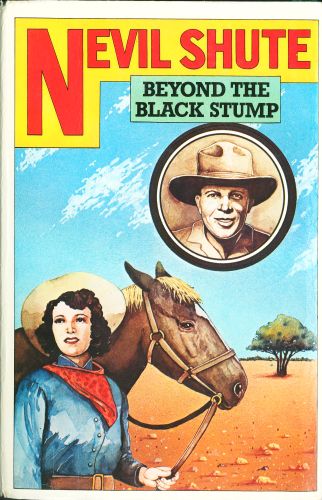

|
| Jacket design by Bill Dare |
| BEYOND THE BLACK STUMP Nevil Shute London: Heinemann, January 1974 (© 1956) |
Rating: 5.0 High |
|||
| ISBN-13 978-0-434-69920-9 | ||||
| ISBN-10 0-434-69920-9 | 297pp. | HC | £4.50 | |
Australia just after World War 2 lay like a promise at the bottom of the Pacific: an unspoiled country vast with potential, a magnet to restless souls eager for new challenges. Its hot, dry Outback became the home to pioneers of all stripes, some with dubious reputations. Beyond the Black Stump depicts the adventures of an American oil geologist, Stanton Laird, in Australia's outback during the 1950s.1 He chooses Australia over Paraguay after an assignment in Saudi Arabia for the Topeka Exploration Company, and oversees the drilling of an exploratory well in the northwest of the country — an arid land of million-acre sheep stations, kangaroos, and abos (or, as Shute calls them in this novel, "gins.")
It turns out that the drilling site is on a sheep ranch called Laragh Station, about 14 miles from the homestead. The owners of the station are Tom and Pat Regan, two old men who had in younger days been snipers for the IRA, involved in the Troubles — specifically the Easter Rebellion of 1916. Each of them had a price on his head in those days. Pat's daughter Mollie is twenty years old; remembering American GIs in Alice Springs during the war, he's not looking forward to seeing Americans again, whatever their profession.
The old man lifted the mouse carefully down from his shoulder and set it down upon the ground at the end of the veranda; he gave it a gentle pat behind and it ran under the house. Then he came up onto the veranda and took the glass of rum his wife held out to him, shot it down in one swallow, and followed it with a chaser of water from the other glass. Then he sat down heavily beside his wife. "Give yeself a rum, Judge," he said. "Give yeself one, David. Americans, is it? Americans on Laragh Station!" He spat scornfully on to the withered grass lawn of the homestead. "If there's money to be gathered any place in the wide world those boys are after it, deep down in the earth on other men's land, ten thousand weary miles from their own rightful place. They'll be after the smell of it, like a pack of rats will find a bit of stinking fish." He flared up suddenly into a fury. "Go on and write the letter, Judge. I'll not have Americans on Laragh Station, not if the Holy Father were to write from Rome itself." – Chapter 2, pages 49-50 |
But Laird and his crew turn out to be decent sorts and soon find a welcome with Pat and his wife. Mollie is especially taken with Stan Laird; he's competent, clean of habit (maybe a little straitlaced) but fun to be with. Also, he corrects the understanding of that nation she's acquired through magazines and movies: America the Decadent. He shows her that most Americans are prosperous but God-fearing folk, and she finds his descriptions of his family, friends, and hometown very appealing. In due course they both take part in the rescue of a English jackeroo who gets blind drunk on Anzac Day and wanders off into the bush. They find the boy and after doing all they can for him they build a fire (which Mollie starts the Abo way) and wait for a truck to find them. During the long conversation which ensues, Stan proposes marriage and Mollie accepts.
It is the third of Shute's novels I have read, and I begin to suspect that a wilderness rescue is characteristic of his novels. In A Town Like Alice it was a horse-riding accident; here it is a young man from England who gets blind drunk and walks out into the raw country. He won't survive there long without protection. Just as in Alice, the main characters take part and solidify their relationship. Indeed, Stanton proposes to Mollie after they find the young man lying unconscious in a riverbed.

 To contact Chris Winter, send email to this address.
To contact Chris Winter, send email to this address.